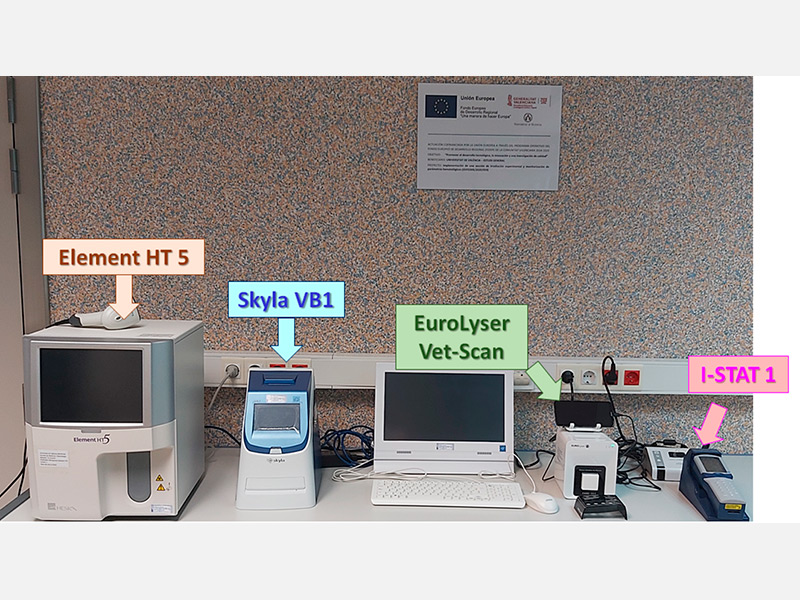
Type: Equipment
This platform can determine the type of blood cells (red, white and platelets). For white blood cells, it also provides information on relative and absolute counts. On the other hand, it allows biochemical analysers to determine a wide range of analytes in blood, serum and plasma.
This platform consists of 4 units:
The haemogram (Element HT5) and 3 biochemical analysers (Skyla VB1, Eurolyser and ISTAT-1), each operating and determining different types of analytes.
Element HT5:
It allows the determination of white blood cells, red blood cells and platelets by incorporating three different laser flow cytometry channels, impedance-based counting and colorimetric detection.
Skyla VB1:
It employs wet chemistry-based rotors to rapidly, efficiently and accurately measure various biochemical indicators in the blood, plasma and/or serum of different species (rats, mice, pigs, rabbits, dogs, etc.). The use of these rotors depends on the type of disease being studied. They can also be used to check the general condition of the animal.
EuroLyser:
This device refines and completes biochemical profiles of many substances such as T4, fructosamine, pancreatic lipase, ammonia, bile acids, phenobarbital, SDMA, cCRP, etc. All measurements are based on wet chemistry principles providing maximum reliability and all with simple and intuitive operability, and in the smallest possible space.
i-STAT-1:
With cartridges containing the appropriate reagents and depending on the type, this analyser can measure the levels of gases (O₂, CO₂...), the chemicals and electrolytes, and the Htc and Hgb levels in the blood. Individual cartridges are also available for the determination of substances such as troponin I, creatinine, etc.
The platform can be used for any type of disease related to alterations in blood components. Additionally, biochemistry analysers contain rotors with specific profiles. Some examples are liver, kidney, thyroid and diabetes. They can also be used to study the physiological and/or physiopathological state of the animal.
For the samples to be accepted by the Metabolomics Service, they must meet the following requirements:
The user must provide detailed information on the source of the sample (animal species), type, quantity (total number of samples and approximate volume), hazard level and recommended precautions.
Samples must be clearly labelled for unambiguous identification.
The user must indicate whether they wish to have the sample returned after completing the measurement or whether they authorise the Service to destroy it.
The Service will not accept:
- infectious or extremely hazardous samples to handle;
- human samples that are not completely anonymous;
- unidentified or incorrectly labelled samples.
To facilitate sample storage and handling, it is recommended that the user provides the samples in a format appropriate to the type and volume of the sample.
The minimum volume for biofluids is 25 µl. For the EDTA haemogram, 220-250 µl (heparin or EDTA, depending on the rotor). For the biochemistry analyser (Skyla VB1) it is recommended to send the samples in separate 1.5 ml flasks.
Whenever possible, it is recommended that the user contacts the Service before beginning sample collection in order to determine the best way to deliver the sample.
If a specific rotor or kit is required to perform the study, the user must contact the person in charge.
Booking webpage: https://ucimreserves.uv.es/IMBM/index.php/login
- Ezzeddin Ayoub, Mustafa
- PIT-Tecnic/a Sup Uv














